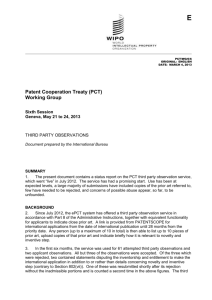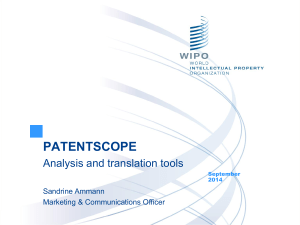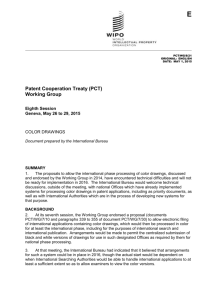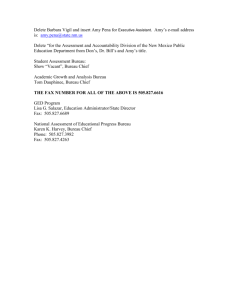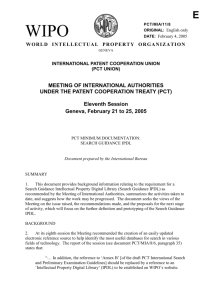Proposed System Architecture and Technical Considerations
advertisement
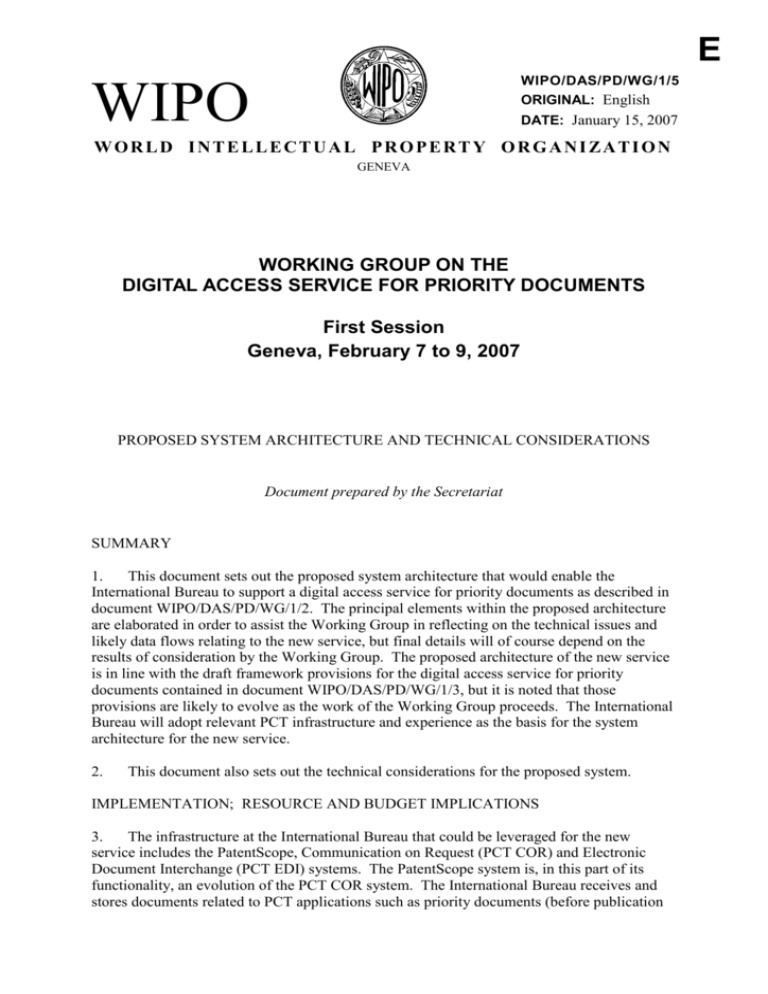
E WIPO/DAS/PD/WG/1/5 WIPO ORIGINAL: English DATE: January 15, 2007 WORLD INTELLECTUAL PROPERTY ORGANIZATION GENEVA WORKING GROUP ON THE DIGITAL ACCESS SERVICE FOR PRIORITY DOCUMENTS First Session Geneva, February 7 to 9, 2007 PROPOSED SYSTEM ARCHITECTURE AND TECHNICAL CONSIDERATIONS Document prepared by the Secretariat SUMMARY 1. This document sets out the proposed system architecture that would enable the International Bureau to support a digital access service for priority documents as described in document WIPO/DAS/PD/WG/1/2. The principal elements within the proposed architecture are elaborated in order to assist the Working Group in reflecting on the technical issues and likely data flows relating to the new service, but final details will of course depend on the results of consideration by the Working Group. The proposed architecture of the new service is in line with the draft framework provisions for the digital access service for priority documents contained in document WIPO/DAS/PD/WG/1/3, but it is noted that those provisions are likely to evolve as the work of the Working Group proceeds. The International Bureau will adopt relevant PCT infrastructure and experience as the basis for the system architecture for the new service. 2. This document also sets out the technical considerations for the proposed system. IMPLEMENTATION; RESOURCE AND BUDGET IMPLICATIONS 3. The infrastructure at the International Bureau that could be leveraged for the new service includes the PatentScope, Communication on Request (PCT COR) and Electronic Document Interchange (PCT EDI) systems. The PatentScope system is, in this part of its functionality, an evolution of the PCT COR system. The International Bureau receives and stores documents related to PCT applications such as priority documents (before publication WIPO/DAS/PD/WG/1/5 page 2 of the PCT application claiming priority) and makes those documents available via PatentScope after publication of the PCT applications concerned. The PCT EDI system provides a secure transport mechanism that is already used to exchange priority documents under the PCT procedure between Patent Offices and the International Bureau. It is proposed that these systems be extended to handle priority documents under the new digital access service. 4. The International Bureau is committed to invest in adapting PatentScope to be compatible with the Trilateral Document Access (TDA) interface systems being established by the Japan Patent Office, the United States Patent and Trademark Office and the European Patent Office, and would also ensure such compatibility in the case of the new service. 5. As most of the technical architecture under a simple start-up system is already available, the majority of the initial investment would be absorbed by the International Bureau in the form of programmer resources adapting existing systems in addition to the work required to analyze, select and then implement a pragmatic authentication scenario from among a number that come to mind. 6. In order to minimize the initial investment in the new service, it is proposed that a simple technical architecture should be adopted at first, based on existing IT systems and infrastructure at the International Bureau. Nevertheless, as experience evolves and system usage increases, it is likely that further investment in the technical architecture may be required so as to maintain required service levels. OVERVIEW OF PROPOSED SYSTEM ARCHITECTURE 7. The digital access service to be operated by the International Bureau would sit alongside priority document access mechanisms established under bilateral arrangements by certain Offices, under which an Office of second filing (OSF) can obtain access to a priority document held in a digital library operating at the Office of first filing (OFF) or another OSF. The fact that the same digital libraries would need to be accessible both under the new service and by such bilateral exchanges emphasizes the need for compatibility of the systems used, while noting that different conditions for access will apply. 8. An overview of the proposed system architecture of the new service to be operated by the International Bureau is illustrated in the following diagram. Roles in each of the three data flows represented (access priority document from OFF; authenticate access; and distribute priority document to OSF) would be played by applicants, OSFs, OFFs and the International Bureau. 9. Priority documents would be made available via the new service in two ways. First, the service will interface with the various OFF digital libraries in operation, provided of course that they meet requirements of quality and compatibility. Second, the International Bureau will place priority documents submitted to it by an applicant or an OFF into its own digital library. The result will be a network of digital libraries accessible under the new service, and enabling the International Bureau to make available priority documents securely accessible to OSFs via PatentScope. WIPO/DAS/PD/WG/1/5 page 3 10. An access code attributed to each priority document will be used to authenticate an OSF’s right to access the priority document securely at PatentScope. The OSF would be able to access PatentScope either via a secure web based interface or via a programmable web services interface. The programmable interface will be TDA compatible, and based on Simple Object Access Protocol (SOAP) technology. The new service would not, of course, require authentication of access once a priority document has become publicly available. Digital Access Service for Priority Documents: Overview of Proposed System Architecture 11. As shown in the above diagram, flexibility will be a central feature of the new service, with several choices available for most elements within the architecture. The implementation of a system architecture based on flexibility would deliver a number of key features, as listed below: (a) possible. Offices and applicants can participate in the system with as little effort as (b) With the eventual potential participation of national and regional Offices in or acting for over 170 countries, the new service needs to cater for varying means of processing, storing and distributing priority documents. (c) Collaboration between Offices and the International Bureau is facilitated. (d) The new service will allow for the accessing of priority documents held in decentralized sources, such as TDA and other digital libraries established by participating Offices, as well as from the digital library maintained by the International Bureau. 12. The International Bureau has had extensive experience with a number of PCT system architecture elements that already offer flexibility and are used in handling priority documents in connection with PCT applications. These elements form the basis of the proposed system architecture described further below. WIPO/DAS/PD/WG/1/5 page 4 13. Upon the request of an Office without the necessary IT infrastructure, the system would cater for paper to be used for each of the principal data flows in the system, including submission of a priority document by an OFF, distribution of a priority document to an OSF, and the making of a request to the International Bureau by an OSF for a priority document. 14. Although not foreseen in the initial development, the new service will in future need to be expanded to provide access to translations of priority documents. ARCHITECTURE ELEMENTS: DOCUMENT FORMAT 15. Strong flexibility is needed for the document format used for priority documents that are sent to the International Bureau by an OFF, reflecting the approach that is already used for transmitting priority documents to the International Bureau under the PCT, in which context three technical specifications are acceptable: (a) “Minimal Specifications for Electronic PCT Document Exchange”, which is a relatively simple PCT-specific specification using PDF and single page TIFF as the supported formats, with indexing information based on folder structure rules and a file naming convention. (b) “WIPO Standard ST.36: Recommendation for the processing of patent information using XML (extensible markup language)”. The purpose of the Standard is to provide logical, system-independent structures for patent document processing, whether for text or image data. The Standard provides XML resources for: full or partial text of patent documents, including bibliographic data, recorded as character coded-data; whole pages of documents represented as one image (page images) irrespective of their content (bibliographic data, text, or images); and data, within full-text documents, which cannot be recorded as character-coded data, such as drawings, chemical formulae, especially complex tables (so-called embedded images) (see section 6 of Standard ST.36). (c) “SDIF (SGML Document Interchange Format)”, a legacy specification established by the Japan Patent Office, the United States Patent and Trademark Office and the European Patent Office, which uses the SGML (Standard Generalized Markup Language) to handle indexing and bibliographic data with documents represented using single page TIFF images. 16. Priority documents made available by the International Bureau to an OSF would be in line with the formats used for priority documents already issued under the PCT via the PatentScope web-site. One format is based on single-page TIFF images of each page of the priority document, and a second format is a single PDF file for the priority document. ARCHITECTURE ELEMENTS: PACKAGING CHANNELS 17. As already applies under the PCT system, participating OFFs would have a choice for making their priority documents accessible over several different packaging channels, namely: (a) Paper (see paragraph 13, above). WIPO/DAS/PD/WG/1/5 page 5 (b) Physical media (such as CD-R or DVD-R). (c) Fully electronically using PCT EDI. This mechanism is based on the Secure File Transfer Protocol (SFTP). SFTP can operate over the Internet and is secure. (d) Fully electronically using a secure digital library. The TDA system, which is based on SOAP technology, is one such system known to the International Bureau that would be suitable as a packaging channel in the new service. 18. The packaging channels for making priority documents accessible to OSFs include: (a) Paper (see paragraph 13, above). (b) Securely over PatentScope, with access protected, until the document is publicly available, using the access code for a priority document. (c) Fully electronically using a secure digital library. The TDA system, which is based on SOAP technology, is one such system known to the International Bureau that would be suitable as a packaging channel in the new service. ARCHITECTURE ELEMENTS: ACCESS SYSTEM 19. The International Bureau expects that new software development is needed for the access system within the new service, as nothing within the existing PCT infrastructure appears suitable for adaptation (since priority documents are made available under the PCT system only when they become publicly available consequent on publication of the PCT application claiming priority). The access system would be based on the following diagram: Digital Access Service For Priority Documents: Example of a Possible System Option 1: Request OFF to make p-doc available to IPDL Applicant Option 2: Obtain p-doc from OFF; send p-doc to IPDL Request OSF to access IPDL; give access code OSF Authenticate request OFF Applicant’s details, incl. address Confirmation and access code Request for access; p-doc details; second filing details; access code IB Access to p-doc P-doc = priority document OFF = Office of first filing OSF = Office of second filing 20. Applicants would have the choice of requesting the OFF to make the priority document available or could obtain the priority document from the OFF themselves. The International Bureau would send to the applicant (using the applicant’s address for correspondence as furnished by the OFF) an access code. Provision of the access code to the OSF by the WIPO/DAS/PD/WG/1/5 page 6 applicant will allow the OSF to request access to the priority document via the digital access service. 21. The system would therefore be a database application, using the same Java and Oracle based environment as most other current PCT developments. The application would need to handle various processes: (a) The exchange of priority document address data with an OFF. (b) Generation and distribution to the applicant of the access code. The system would require the access code to be sent via normal mail (or possibly fax or certified email) to the applicant’s address (or other contact details) held on record at the OFF for the application which constitutes the priority document. The applicant’s right to authorize access to the priority document is ensured by sending the access code only to that address. (c) Management of access codes, such as canceling lost codes, generating new codes, and tracking requests for a given access code. (d) The validation of priority document access requests against the business rules of the system as they emerge. Validation checks would include verification of an access code against priority document meta-data (such as Office, name of applicant, application number and filing date). TECHNICAL CONSIDERATIONS 22. The following is a summary of some technical considerations that need to be addressed in developing the digital access service: (a) Initially, the system will only support black and white documents; color and gray-scale will not be supported. (b) Further consideration is needed of how to handle possible withdrawal by the applicant of permission to distribute a priority document. (c) Handling of translations of priority documents will be required as a future development. (d) The system must support paper-based submission and distribution of priority documents, and access requests, for the benefit of smaller Offices. (e) The system will need to handle lost or compromised access codes. (f) Consideration is needed of how to handle changes in applicant information, such as address for correspondence, changes in ownership, deceased applicants, etc. (g) The trigger to make a priority document available to the digital access service can be the dispatch of priority document address data from the OFF to the access system. Consideration is needed as to how the OFF may implement such a procedure, be it in a paper-based or electronic fashion. WIPO/DAS/PD/WG/1/5 page 7 (h) Since authentication of access via the service relies on an access code for each priority document, applicants must be made aware of the need to keep access codes secure and to send them to other parties (such as the OSF) in a secure fashion, such as via normal mail. 23. The Working Group is invited to consider and comment on the proposed system architecture and technical considerations set out in this document. [End of document]
